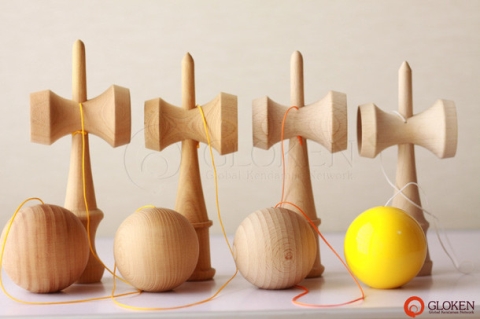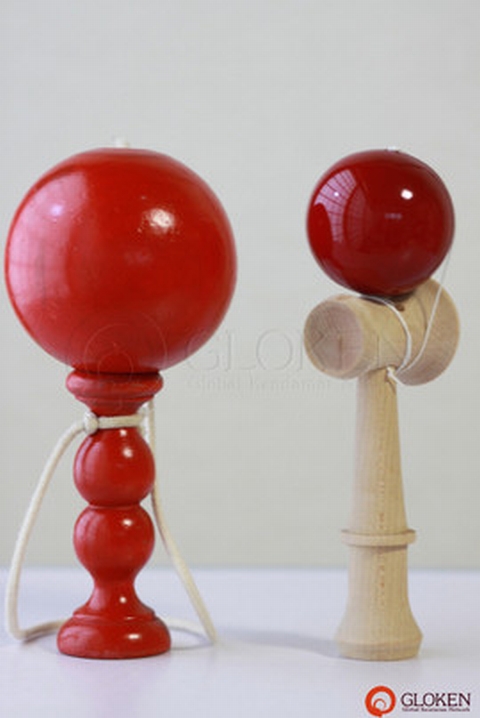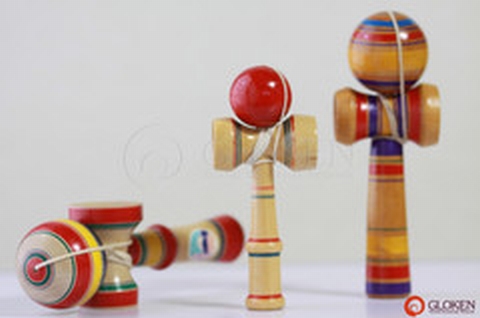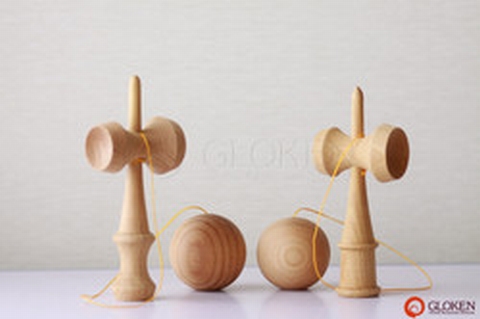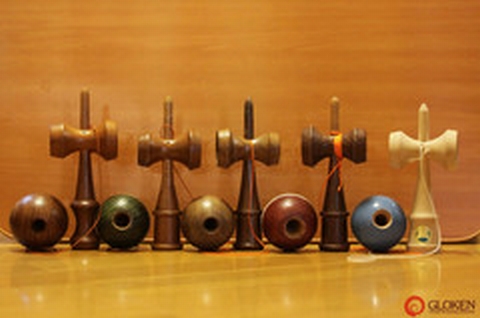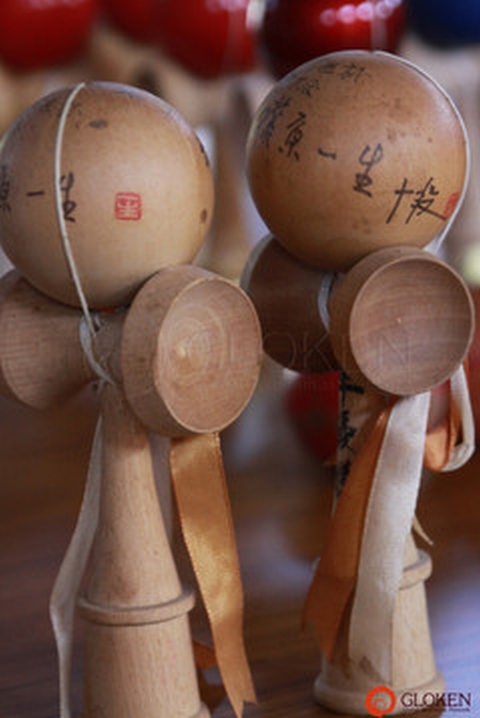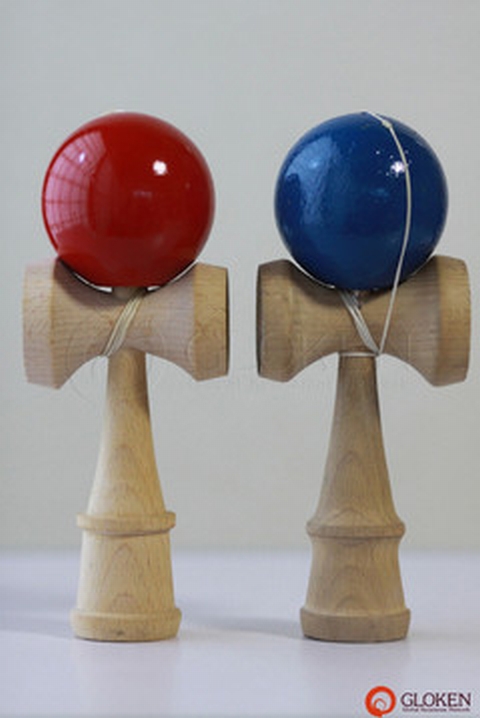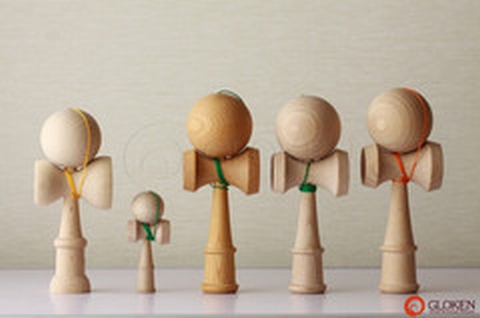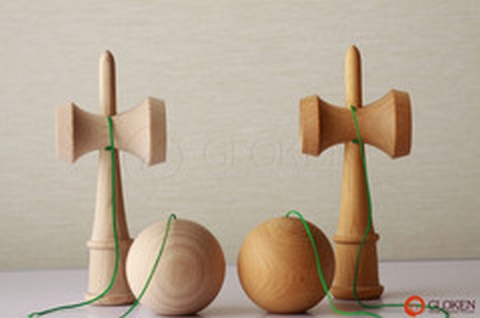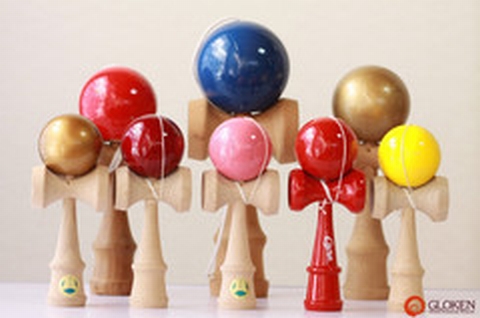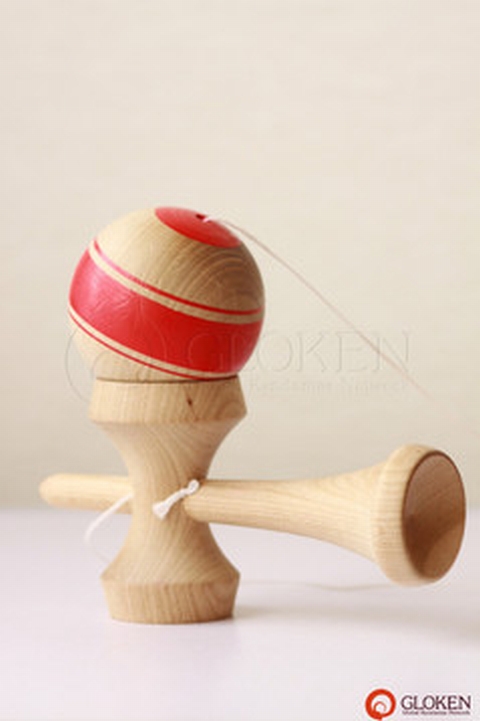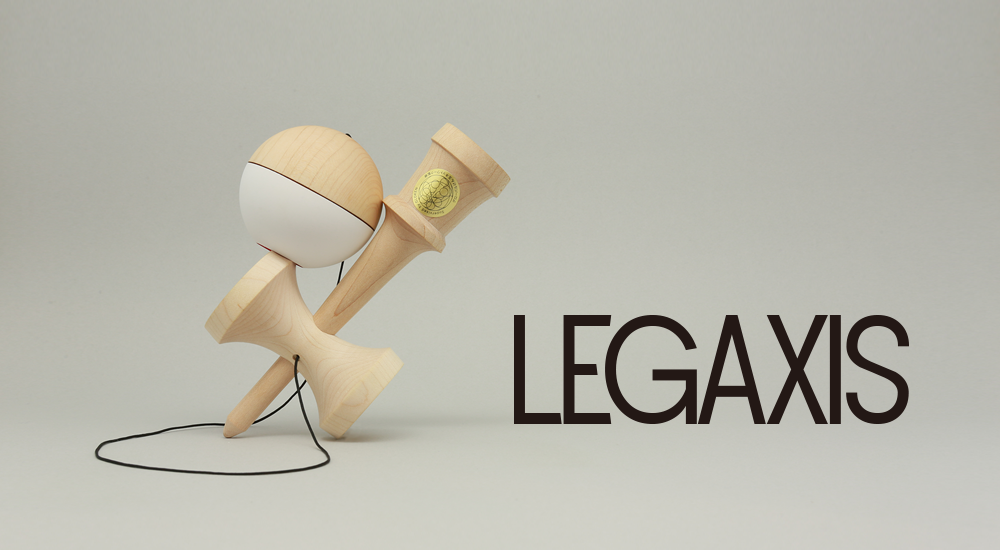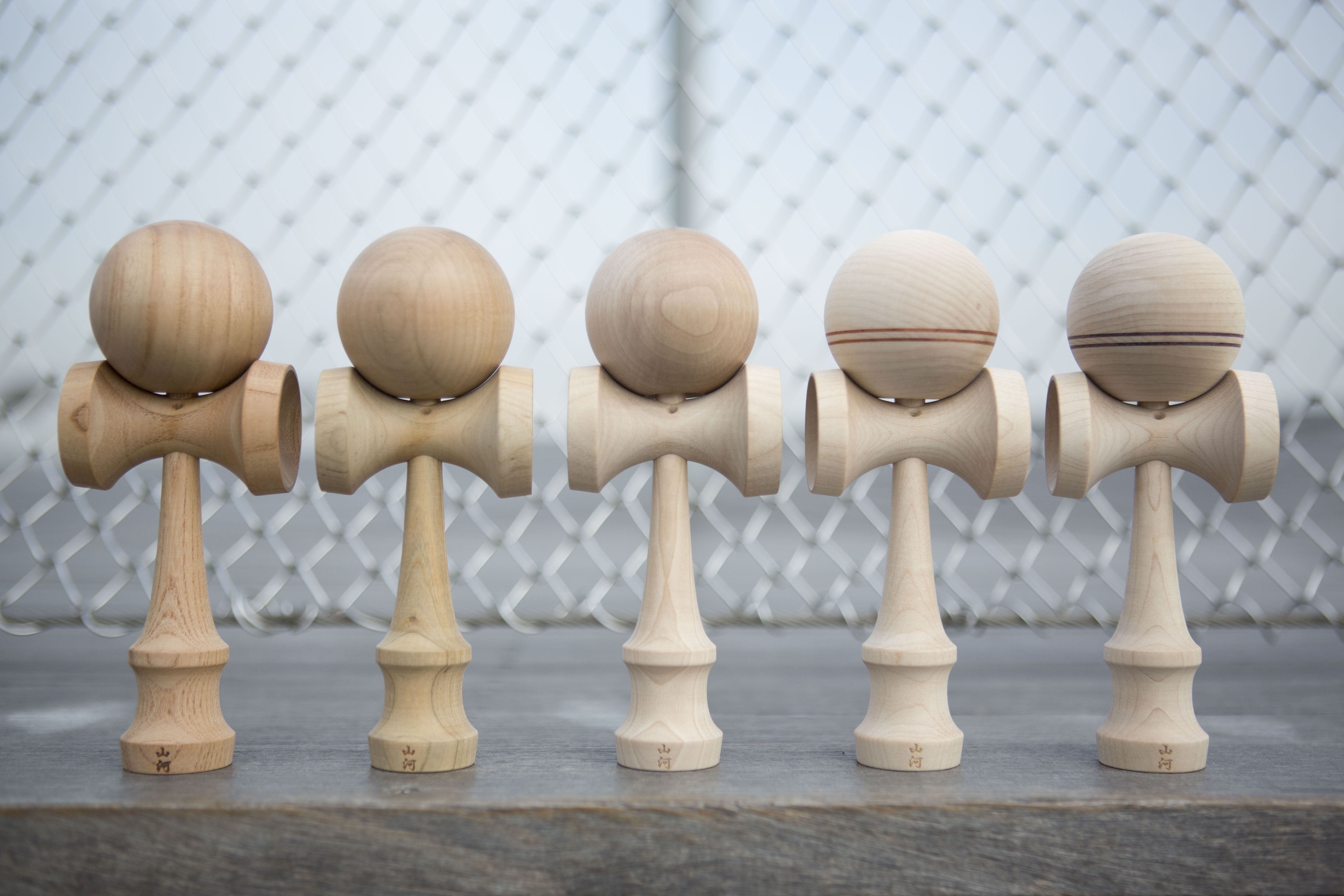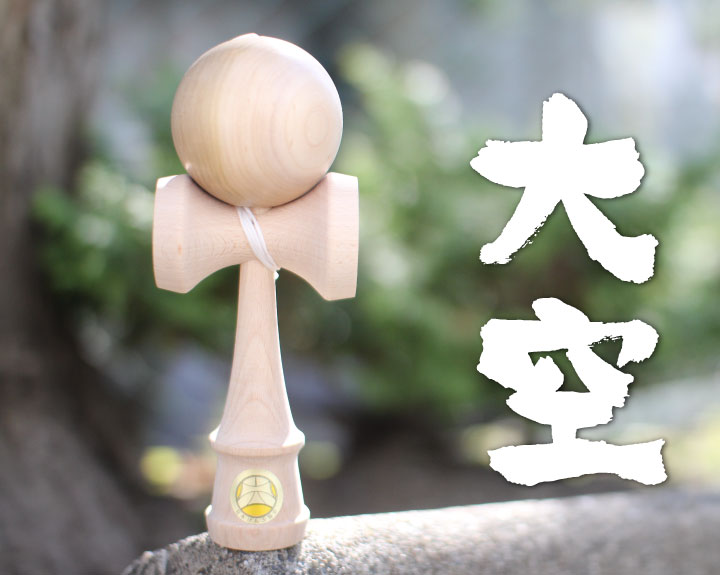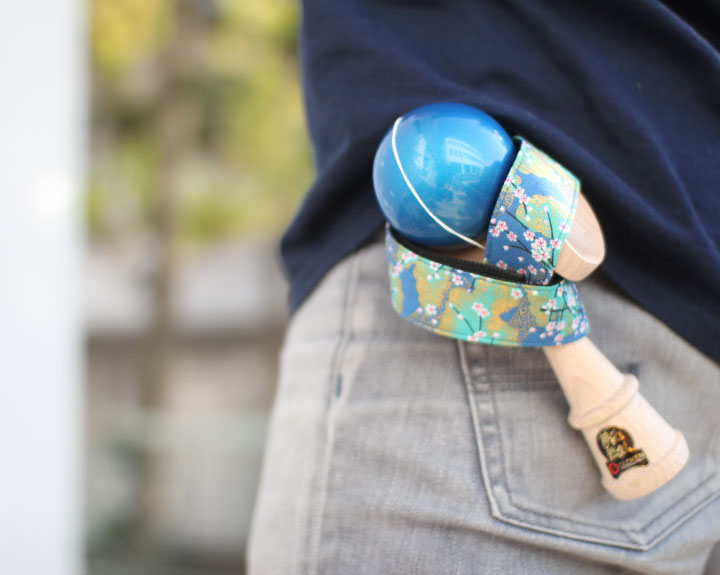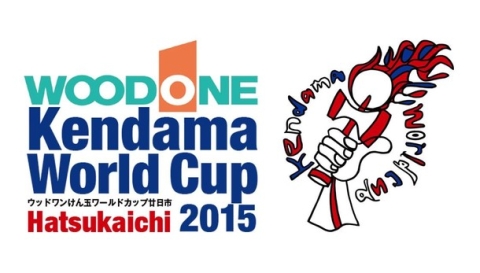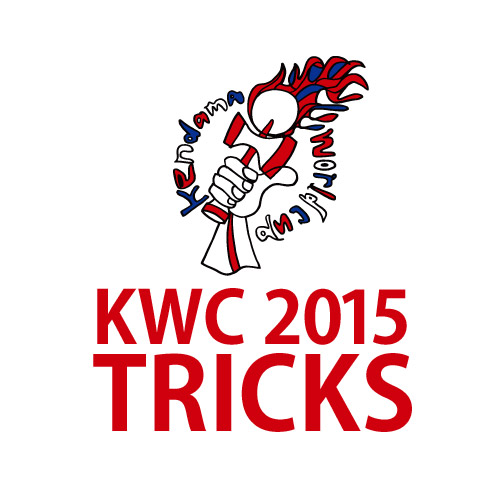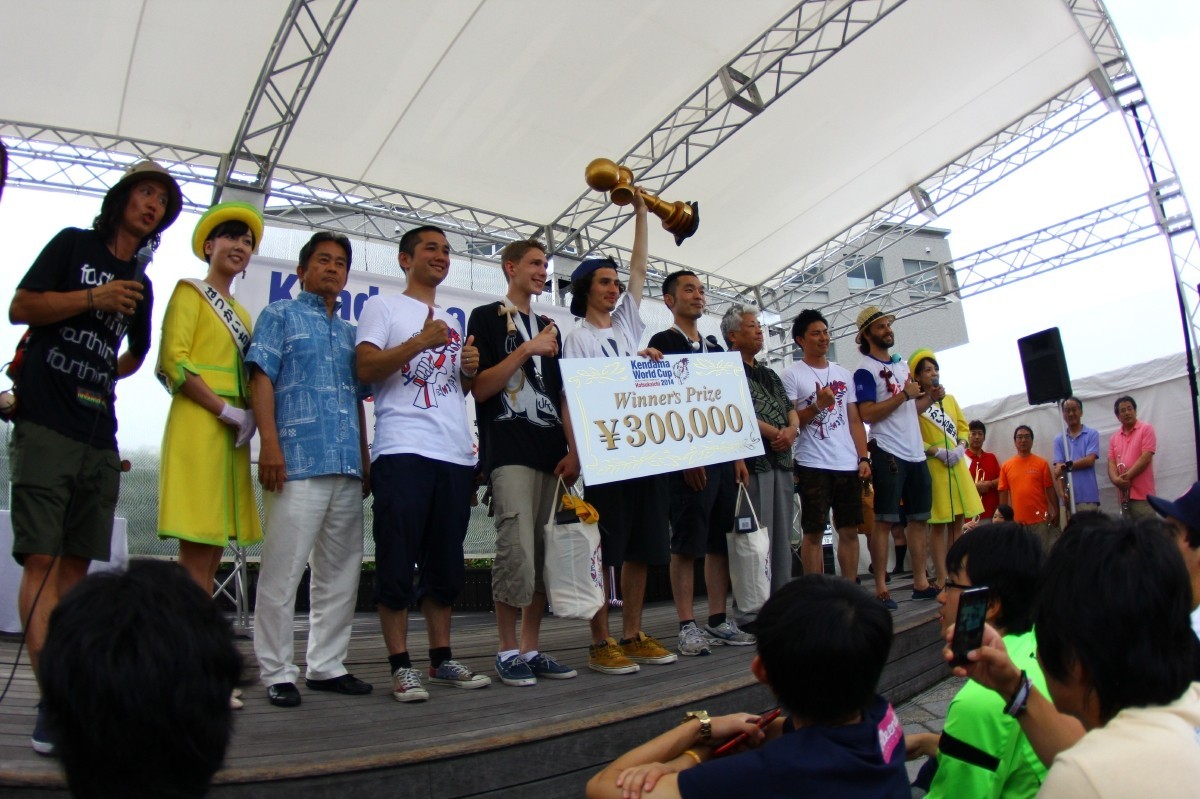Changing Process of Competition Models
*S-18, S-17, Tortoise-17, JKA certified model from the left
We show an outline of Kendama history. We would like to give more details about history of kendamas later.
*Bilboquet (left), Nichi-Getsu Ball (right)
In the Left of the picture; called “Biboquet”, has been played in Europe around 16th century or earlier.
After Bilboquet had been introduced to Japan, the first kendama called Nichi Getsu Ball (sun moon ball) was invented by Mr. Hamatsugu Ekusa, lived in Kure, Hiroshima, in 1919. Hongo woodworking factory in Hatsukaichi city, Hiroshima started a mass production from 1921. At the peak period, about 300,000 kendamas in a year were made in many kendama factories in Hatsukaichi.
The kendama boom started in the 1930s in Japan. Various and sundry kendama plays and games were created in each area as a toy or plaything for children.
*Lined folk craft kendamas
Folk craft kendamas are made in the factories which have the spinning lathe technology used for Kokeshi dolls in Tohoku, Komas in Odawara etc.
Nichi-Getsu Balls and folk craft kendamas are just for children’s toy or the souvenirs, not designed for improving the kendama technique or for competitions.
Children modified their kendamas such as widening the hole of tama(ball) or put a metal pencil cap on the spike in order to achieve the tricks easily.
*S-type; the dawn of the competition models
In these circumstances, Tokyo Kendama Club was settled in 1968 by kendama lovers who enjoyed playing kendama deeply and also developed advanced tricks. The leader was a researcher of kendama, also designed and kept modifying its shape with wood craftsmen. The first prototype model for competition was made in Miyagi in 1976.
On the other hand, Japan Kendama Association (JKA), established in 1975, asked the designer of S-type kendama to produce JKA model in 1977.
According to the designer, JKA models such as old-Fuji or old-Sakura were modeled on S-17 type. At the time, ken(handle) was designed to be 16.8cm height, however, JKA members measured its shortened ken, the JKA model was made at the height of 16cm.
*S-types at the designer’s house (right is JKA model)
Left picture; four kendamas from the left are S-types made in 1975. At that time, a wide variety of materials of kendamas are used, such as precious rosewood, angsana, and zelkova, they are still shiny throughout the decades.
Many kendama toys sold even in the candy store were made of zelkova material, rough, but good quality of its texture seems to have been popular.
Afterwards, beech and cherry are often used instead of zelkova as raising the cost of wood, nowadays almost all kendamas are made of beech in Japan (some makers uses cherry for the balls).
*JKA Models in the beginning
Left picture; JKA certified kendamas in early times, autographs signed by the first chairman. In order to spread kendamas as a sporting event, JKA unified the rules and created certified kendamas (16-type) in Japan.
Though kendama was only aware of as a mere children’s play toys at that time, JKA has started to popularize certified kendamas adopting the elements of sports and establishing “Kendama-do” system such as “Kyu” or “Dan” certificate.
JKA’s significant achievements are the improvement of technical level (especially basic tricks with accuracy) and holding nationwide competitions. Those brought kendama spread widely in Japan.
However, as a result, variety shapes of kendamas and the original ways of playing in each local area were perished with the spread of certified kendama. JKA’s rules and regulations came from only one area (school of thought), and the others were never recommended. These approaches tend to prevent Japanese kendama players from complete freedom in their choice of creating new ways of playing kendama with full of imagination.
*JKA Freshened the design in 2000
Recently, JKA models have become the most popular kendama in Japan; however, there are still many fans of S-type kendama, the first competition model.
The S-types had been produced until 1990 by Mingei Koeki company in collaboration with Japan Kendama Lovers’ Society, former Tokyo Kendama Club. (Japan Kendama Lovers’ Society disbanded with S-type in May, 1990).
JKA models are made by some makers with a small modification of design in 2000. On the left of the photo is the old type and the right is the new one. The new model has a rounded sarado (crosspiece connecting big and small cups) and suberidome (slip stop grip). In addition, the position of string hole on sarado (crosspiece) was slightly changed, and it’s impossible to figure out from the photo.
Many kendamas for competition have this shape lately.
*Tortoise Inc. follows the S-types
After S-types had fallen the curtain on the history of 14 years in 1990, Tortoise Inc. followed them as T-8, T-14, T-16 and T-17, not using the name of “S”.
In the left of the photo: T-14, T-8, T-16 keyaki, T-16, T-17
From left to right, all made of beech except T-16 keyaki.
*T-16 (left) and T-16 Keyaki (right)
T-16 keyaki are made of keyaki wood (Japanese zelkova); their color and texture are excellent, but they will be discontinued by the end of 2012 for lack of the wood.
Keyaki wood itself is very hard, yet its texture and touch is rather soft, less bounce when hitting ken(handle) with tama(ball). We admire the wisdom of the ancients for using keyaki wood that is also a superior good durability.
*Mugens; tremendous respect and admiration from the kendama competitors.
If defined “for competition” as kendamas that are designed to achieve tricks easier, various kinds of shapes and design have been created as described above.
Although having been produced by some kendama makers, “Mugen”, by Iwata wood factory, had an excellent reputation with their superb quality among the top players in Japan.
Mugens were produced from 2002 through 2008. Due to some disagreements with JKA, Iwata wood factory decided to discontinue making kendamas anymore, yet JKA committee has never explained the details to their members. Mugen still seems to be the most prestigious kendama among kendama lovers.
It is simply natural that kendama players compete their technique and try to achieve more advanced tricks than before.
These are the story of competition models that was born to make tricks easier and to sophisticate the techniques. The evolution of kendamas has led to raise the levels of players’ skills, or vice versa.
We are sure kendama will continue to grow, including shape, technique, and worldwide popularity.
Kendama may vary its size, shape or material with each person it fits, and even if it is appear to be the same kendama, its weight and texture is still slightly different from each other.
Looking for the one that fits nicely into your own hands, is one of the ways to enjoy Kendama.
GLOKEN is happy to let you know about kendamas as much as possible and help you to choose valued and long-lasting kendama, with getting involved in the design and development.
Thank you for reading until the bottom. Your feedbacks always encourage us to keep moving! We appreciate any inquiries and comments about this page. Please feel free to contact us .


